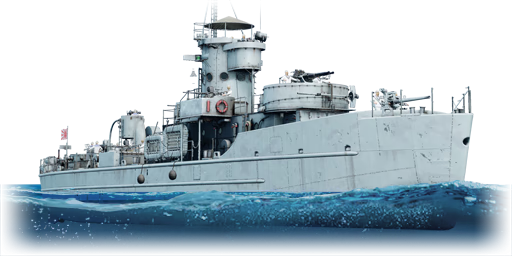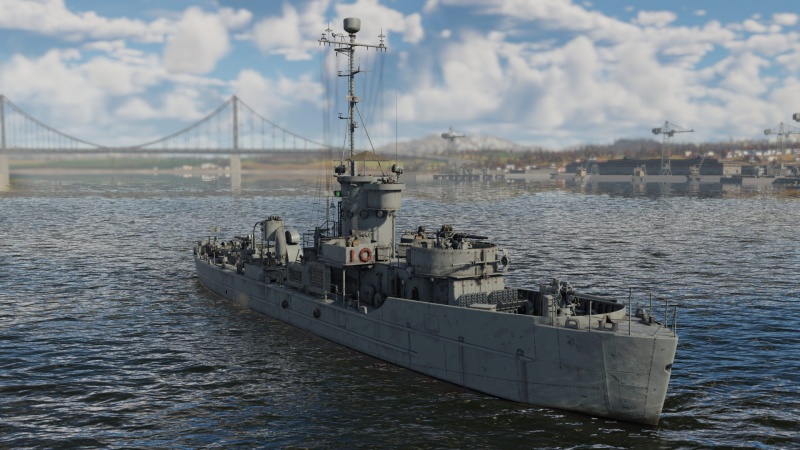Difference between revisions of "Asagao (YTE-01)"
(Paragraphs filled: Pros and cons, Media (still improvable), See also. To do: Upload an image of the Asagao in battle (don't know how to do yet).) (Tag: Visual edit) |
m (Tag: Visual edit) |
||
| Line 100: | Line 100: | ||
=== Videos === | === Videos === | ||
| − | {{Youtube-gallery|https://www.youtube.com/watch?v=TDzYxB7im8k | + | {{Youtube-gallery|https://www.youtube.com/watch?v=TDzYxB7im8k}} |
== See also == | == See also == | ||
Revision as of 07:31, 10 October 2024
| This page is about the Japan motor gun boat Asagao (YTE-01). For other versions, see Landing Craft Support (Family). |
Contents
Description
Laid down in 1944 as American Landing Craft Support LCS(L)(3)-9, Asagao started its career in the Asia-Pacific, delivering supplies to Filipino guerrillas and harassing Japanese targets in the region. With the end of the war, the ship was placed in reserve and renamed LSSL-9. In 1950, LSSL-9 was assigned to France, where she was named RFS Hallebarde (L-9023), but she returned to the United States by 1955.
However, in 1956, along with a batch of fifty other LSSLs, the vessel was transferred to the Japan Self-Defense Force, where the batch was reclassified as the Yuri-class of patrol ships and the vessel was given a new name: JDS Asagao (あさがお), after the flower morning glory (family Convolvulaceae). Her service in the JSDF was entirely uneventful, being used as a training vessel before returning back to the US Navy in April 1965. The ship was then leased to South Vietnam in September 1965 as RVNS Đoàn Ngọc Tang (HQ-228), but with the fall of South Vietnam in 1975, she escaped to the Philippines, where she was loaned to the local government and remained under the name RPS La Union (LF-50) until her decommissioning in the 1980s.
The Yuri-class, Asagao (YTE-01) was introduced in Update "Air Superiority". In combat, she can outgun most motor torpedo boats and other light vessels, while also being a good anti-air platform. However, her low speed and mediocre survivability make her struggle with frigates and other high-BR vessels. She's a relatively large vessel with an unusually low draft, making her able to reach locations more typically accessible to the torpedo boats, with which she also shares spawn points. Her unique feature, compared to the other LCS's, is a rank III modification enabling the use of 120 Mk7 barrage rockets.
General info
Survivability and armour
Talk about the vehicle's armour. Note the most well-defended and most vulnerable zones, e.g. the ammo magazine. Evaluate the composition of components and assemblies responsible for movement and manoeuvrability. Evaluate the survivability of the primary and secondary armaments separately. Don't forget to mention the size of the crew, which plays an important role in fleet mechanics. Save tips on preserving survivability for the "Usage in battles" section. If necessary, use a graphical template to show the most well-protected or most vulnerable points in the armour.
Mobility
Write about the ship's mobility. Evaluate its power and manoeuvrability, rudder rerouting speed, stopping speed at full tilt, with its maximum forward and reverse speed.
| Mobility Characteristics | |||
|---|---|---|---|
| Game Mode | Upgrade Status | Maximum Speed (km/h) | |
| Forward | Reverse | ||
| AB | |||
| Upgraded | 30 | 19 | |
| RB/SB | |||
| Upgraded | 22 | 14 | |
Modifications and economy
Armament
Primary armament
Provide information about the characteristics of the primary armament. Evaluate their efficacy in battle based on their reload speed, ballistics and the capacity of their shells. Add a link to the main article about the weapon: {{main|Weapon name (calibre)}}. Broadly describe the ammunition available for the primary armament, and provide recommendations on how to use it and which ammunition to choose.
- Universal: AP-T · HEFI-T
- 40 mm HE clips: HEFI-T · HEFI-T · HEFI-T · AP-T
- 40 mm AP clips: AP-T · AP-T · AP-T · HEFI-T
| Penetration statistics | |||||||
|---|---|---|---|---|---|---|---|
| Ammunition | Penetration @ 0° Angle of Attack (mm) | ||||||
| 10 m | 100 m | 500 m | 1,000 m | 1,500 m | 2,000 m | ||
| HEFI-T | 3 | 3 | 3 | 3 | 3 | 3 | |
| AP-T | 81 | 78 | 68 | 58 | 49 | 41 | |
| Shell details | ||||||||||||
|---|---|---|---|---|---|---|---|---|---|---|---|---|
| Ammunition | Velocity (m/s) |
Projectile mass (kg) |
Fuse delay (m) |
Fuse sensitivity (mm) |
Explosive mass (TNT equivalent) (g) |
Ricochet | ||||||
| 0% | 50% | 100% | ||||||||||
| HEFI-T | 874 | 0.9 | 0 | 0.1 | 67.13 | 79° | 80° | 81° | ||||
| AP-T | 874 | 0.89 | - | - | - | 47° | 60° | 65° | ||||
Secondary armament
Some ships are fitted with weapons of various calibres. Secondary armaments are defined as weapons chosen with the control Select secondary weapon. Evaluate the secondary armaments and give advice on how to use them. Describe the ammunition available for the secondary armament. Provide recommendations on how to use them and which ammunition to choose. Remember that any anti-air armament, even heavy calibre weapons, belong in the next section. If there is no secondary armament, remove this section.
| Penetration statistics | |||||||
|---|---|---|---|---|---|---|---|
| Ammunition | Type of warhead |
Penetration @ 0° Angle of Attack (mm) | |||||
| 100 m | 1,000 m | 2,000 m | 3,000 m | 4,000 m | 5,000 m | ||
| HC Mk.27 | HE | 8 | 8 | 8 | 8 | 8 | 8 |
| AP Mk.29 | APCBC | 111 | 90 | 71 | 56 | 44 | 36 |
| AA Mk.31 | HE-VT | 7 | 7 | 7 | 7 | 7 | 7 |
| Shell details | ||||||||||||
|---|---|---|---|---|---|---|---|---|---|---|---|---|
| Ammunition | Type of warhead |
Velocity (m/s) |
Projectile mass (kg) |
Fuse delay (s) |
Fuse sensitivity (mm) |
Explosive mass (TNT equivalent) (g) |
Ricochet | |||||
| 0% | 50% | 100% | ||||||||||
| HC Mk.27 | HE | 823 | 5.9 | 0 | 0.1 | 500 | 79° | 80° | 81° | |||
| AP Mk.29 | APCBC | 823 | 5.9 | 0.01 | 4 | 133.28 | 48° | 63° | 71° | |||
| Proximity-fused shell details | ||||||||||||
|---|---|---|---|---|---|---|---|---|---|---|---|---|
| Ammunition | Type of warhead |
Velocity (m/s) |
Projectile mass (kg) |
Fuse delay (m) |
Fuse sensitivity (mm) |
Arming distance (m) |
Trigger radius (m) |
Explosive mass (TNT equivalent) (g) |
Ricochet | |||
| 0% | 50% | 100% | ||||||||||
| AA Mk.31 | HE-VT | 823 | 5.85 | 0 | 0.1 | 548 | 15 | 352.8 | 79° | 80° | 81° | |
Anti-aircraft armament
An important part of the ship's armament responsible for air defence. Anti-aircraft armament is defined by the weapon chosen with the control Select anti-aircraft weapons. Talk about the ship's anti-air cannons and machine guns, the number of guns and their positions, their effective range, and about their overall effectiveness – including against surface targets. If there are no anti-aircraft armaments, remove this section.
Additional armament
Describe the available additional armaments of the ship: depth charges, mines, torpedoes. Talk about their positions, available ammunition and launch features such as dead zones of torpedoes. If there is no additional armament, remove this section.
Usage in battles
Describe the technique of using this ship, the characteristics of her use in a team and tips on strategy. Abstain from writing an entire guide – don't try to provide a single point of view, but give the reader food for thought. Talk about the most dangerous opponents for this vehicle and provide recommendations on fighting them. If necessary, note the specifics of playing with this vehicle in various modes (AB, RB, SB).
Pros and cons
Pros:
- Incredible firepower against other coastal ship types: Anything but heavily armoured gunboats and subchasers can be shredded in very short time.
- Decent anti-air capability due to dedicated AA armament and access to the AA Mk.31 HE-VT shell for the 76 mm secondary gun.
- Large crew count of 65 people allows to survive moderate amount of enemy fire.
- In opposition to the American and Italian counterparts, the Asagao (YTE-01) gets access to 4.5 inch Mk7 barrage rockets.
- Frontal twin configuration of Bofors L/60 Mark 1 autocannons is greatly heightened. This allows to hide large parts of the ship and engage enemies behind cover.
Cons:
- Extremely slow top speed of only 22 km/h - even slower than the American and Italian representatives of this ship class.
- This plus the large size of the Asagao makes evading enemy torpedoes, artillery and gunfire a very difficult task.
- Usually suffers high crew losses during fires on board.
- 4.5 inch Mk7 barrage rockets have fixed forward firing angle and distance of impact: Hitting enemies with these require several salvos and prediction of enemy movements.
History
Describe the history of the creation and combat usage of the ship in more detail than in the introduction. If the historical reference turns out to be too long, take it to a separate article, taking a link to the article about the ship and adding a block "/History" (example: https://wiki.warthunder.com/(Ship-name)/History) and add a link to it here using the main template. Be sure to reference text and sources by using <ref></ref>, as well as adding them at the end of the article with <references />. This section may also include the ship's dev blog entry (if applicable) and the in-game encyclopedia description (under === In-game description ===, also if applicable).
Media
Videos
See also
Other vessels of the Landing Craft, Support (Large) class:
Family of Landing Craft Support ships:
External links
Paste links to sources and external resources, such as:
- topic on the official game forum;
- other literature.
| George Lawley and Sons | |
|---|---|
| Submarine Chasers | |
| 173’ PC | Carmi (PC-466) |
| Landing Craft | |
| LCS(L)(3) | Asagao (YTE-01)* |
| *ex-LCS(L)(3)-9 in Japanese service | |
| Japan boats | |
|---|---|
| Motor torpedo boats | Type T-1 · Type T-14 · Type T-14 (mod. 1) · Type T-38 · Type T-51a · Type T-51b |
| PT-802 · PT-808 · PT-15 | |
| Motor gun boats | Ha-Go (mod. 1) · Type 4 (mod. 2) · Type 4 (Mod 4) |
| Asagao (YTE-01) · PG 02 | |
| Armoured gun boats | Soukou-Tei · Soukou-Tei No.4 |
| Gunboats | Chidori |





